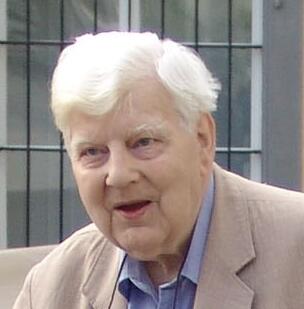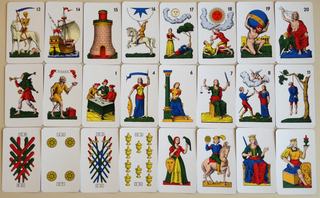
Tarot is a pack of playing cards, used from at least the mid-15th century in various parts of Europe to play card games such as Tarocchini. From their Italian roots, tarot-playing cards spread to most of Europe, evolving into a family of games that includes German Grosstarok and modern games such as French Tarot and Austrian Königrufen. In the late 18th century French occultists made elaborate, but unsubstantiated, claims about their history and meaning, leading to the emergence of custom decks for use in divination via tarot card reading and cartomancy. Thus, there are two distinct types of tarot packs in circulation: those used for card games and those used for divination. However, some older patterns, such as the Tarot de Marseille, originally intended for playing card games, are occasionally used for cartomancy.

The Magician (I), also known as The Magus or The Juggler, is the first trump or Major Arcana card in most traditional tarot decks. It is used in game playing and divination; in the English-speaking world, the divination meaning is much better known.

Andrea Mantegna was an Italian painter, a student of Roman archeology, and son-in-law of Jacopo Bellini.

Sir Michael Anthony Eardley Dummett was an English academic described as "among the most significant British philosophers of the last century and a leading campaigner for racial tolerance and equality." He was, until 1992, Wykeham Professor of Logic at the University of Oxford. He wrote on the history of analytic philosophy, notably as an interpreter of Frege, and made original contributions particularly in the philosophies of mathematics, logic, language and metaphysics.

Strength is a Major Arcana tarot card, and is numbered either XI or VIII, depending on the deck. Historically it was called Fortitude, and in the Thoth Tarot deck it is called Lust. This card is used in game playing as well as in divination.

The Visconti-Sforza Tarot is used collectively to refer to incomplete sets of approximately 15 decks from the middle of the 15th century, now located in various museums, libraries, and private collections around the world. No complete deck has survived; rather, some collections boast a few face cards, while some consist of a single card. They are the oldest surviving tarot cards and date back to a period when tarot was still called Trionfi cards, and used for everyday playing. They were commissioned by Filippo Maria Visconti, Duke of Milan, and by his successor and son-in-law Francesco Sforza. They had a significant impact on the visual composition, card numbering and interpretation of modern decks.

The Mantegna Tarocchi, also known as the Tarocchi Cards, Tarocchi in the style of Mantegna, Baldini Cards, are two different sets each of fifty 15th-century Italian old master prints in engraving, by two different unknown artists. The sets are known as the E-series Tarocchi Cards and the S-series Tarocchi Cards, and their artists are known as the “Master of the E-series Tarocchi” and the “Master of the S-series Tarocchi”. There are also a number of copies and later versions. Despite their name, they are educational visual aids, showing personifications of social classes or abstractions.

Trionfi are 15th-century Italian playing card trumps with allegorical content related to those used in tarocchi games. The general English expression "trump card" and the German "trumpfen" have developed from the Italian "Trionfi". Most cards feature the personification of a place or abstraction.

Robert M. Place is an American artist and author known for his work on tarot history, symbolism, and divination.
The decade of the 1460s in art involved some significant events.

The Tarot Garden is a sculpture garden based on the esoteric tarot, created by the French-American artist Niki de Saint Phalle (1930–2002) in Pescia Fiorentina, località Garavicchio, in the municipality of Capalbio, province of Grosseto, Tuscany, Italy. The park was opened to the public in 1998.
The Tarocco Piemontese is a type of tarot deck of Italian origin. It is the most common tarot playing set in northern Italy, much more common than the Tarocco Bolognese. The most popular Piedmontese tarot games are Scarto, Mitigati, Chiamare il Re, and Partita which are played in Pinerolo and Turin. This deck is considered part of Piedmontese culture and appeared in the 2006 Winter Olympics closing ceremony held in Turin. As this was the standard tarot pack of the Kingdom of Sardinia, it was also formerly used in Savoy and Nice before their annexation by France. Additionally, it was used as an alternative to the Tarocco Siciliano in Calatafimi-Segesta, Sicily. Outside of Italy, it is used by a small number of players in Ticino, Switzerland and was used by Italian Argentines.

Tarot games are card games played with tarot packs designed for card play and which have a permanent trump suit alongside the usual four card suits. The games and packs which English-speakers call by the French name Tarot are called Tarocchi in the original Italian, Tarock in German and similar words in other languages.
Dal Negro is an Italian company that produces playing cards, tarot cards, divination cards, chess, backgammon, roulette wheels, and toys for children.

The Tarocco Siciliano is a tarot deck found in Sicily and is used to play Sicilian tarocchi. It is one of the three traditional Latin-suited tarot decks still used for games in Italy, the others being the more prevalent Tarocco Piemontese and the Tarocco Bolognese. The deck was heavily influenced by the Tarocco Bolognese and the Minchiate. It is also the only surviving tarot deck to use the Portuguese variation of the Latin suits of cups, coins, swords, and clubs which died out in the late 19th and early 20th centuries.

Giuseppe Maria Mitelli (1634–1718) was an Italian engraver and painter of the Baroque period. He was the son of the prominent quadratura painter Agostino Mitelli. The younger Mitelli was best known for his prolific engravings, in a great variety of subjects, including scenes from grand epics to mundane page boards for games of chance using dice, Tarot cards, and an Iconophor with anthropomorphized alphabets. He also engraved genre subjects, allegories, moralistic scenes, but even some bizarre cartoons that could be interpreted as sometimes provocatively subversive, or presciently revolutionary, and sometimes imaginatively bizarre. He often depicted dwarfs engaged in buffoonery or satirical depictions of aphorisms, which recalls the Bambocciate di nani or arte pigmeo of genre painter Faustino Bocchi (1659–1742).

The Fool is one of the 78 cards in a tarot deck. In tarot card reading, it is one of the 22 Major Arcana, sometimes numbered as 0 or XXII. However, in decks designed for playing traditional tarot card games, it is typically unnumbered, as it is not one of the 21 trump cards and instead serves a unique purpose by itself.

The Sola Busca tarot is the earliest completely extant example of a 78-card tarot deck. It is also the earliest tarot deck in which all the plain suit cards are illustrated and it is also the earliest tarot deck in which the trump card illustrations deviate from the classic tarot iconography. Unlike the earlier Visconti-Sforza tarot decks, the cards of the Sola Busca are numbered. The trump cards have Roman numerals while the pips of the plain suits have Hindu Arabic numerals.The deck was created by an unknown artist and engraved onto metal in the late 15th century. A single complete hand-painted deck is known to exist, along with 35 uncolored cards held by various museums. The deck is notable not only for its age, but also for the quality of its artwork, which is characterized by expressive figures engraved with precise contours and shading. Various theories have been suggested about who created the deck, but its authorship remains uncertain.

The Tarot de Besançon, also called the Besançon Tarot, describes an historical type of Tarot pack used for playing card games that was made in south Germany, France and Switzerland, including the town of Besançon.
Thierry Depaulis is an independent historian of games and especially of playing cards, card games, and board games. He is President of the association Le Vieux Papier, a member of the editorial board of the International Board Game Studies Association, and a member of the board of directors of the foundation of the Swiss Museum of Games. He was President of the International Playing-Card Society from 2017 to 2022.
















